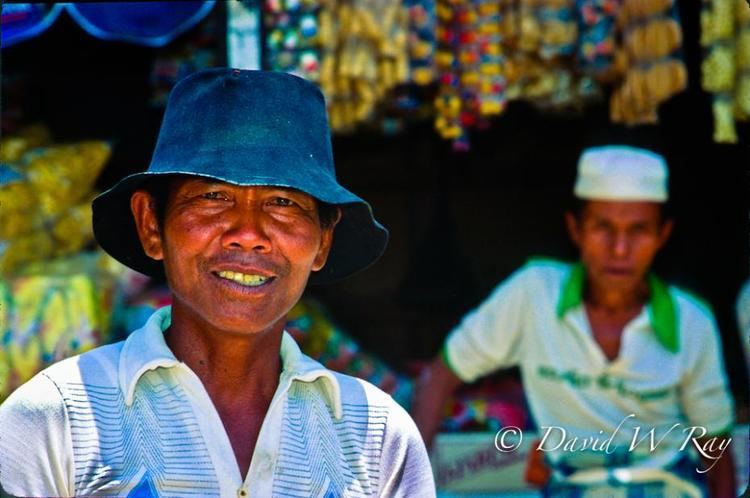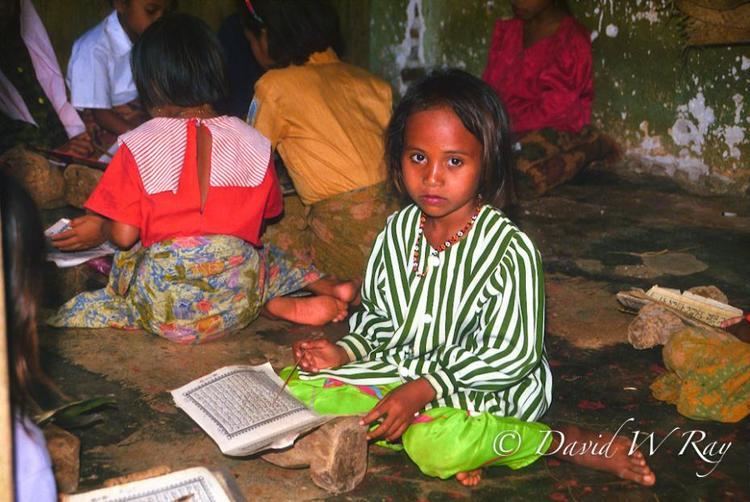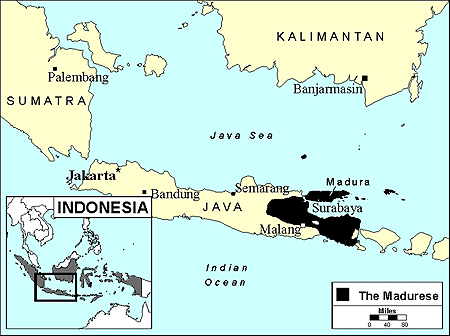East Java 6,520,403 Jakarta 79,925 East Kalimantan 46,823 | West Kalimantan 274,869 South Kalimantan 53,002 West Java 43,001 | |
 | ||
Borneo clashes between ethnic groups continue
The Madurese (sometimes Madurace or Madhure) also known as Orang Madura and Suku Madura in Indonesian are an ethnic group originally from the island of Madura now found in many parts of Indonesia, where they are the third-largest ethnic group by population. Common to most Madurese throughout the archipelago is the Islamic religion and the use of the Madurese language.
Contents
- Borneo clashes between ethnic groups continue
- Language and religion
- Culture
- Social Character
- Transmigration
- Lifestyle
- References

The Madurese are a religious ethnicity, often affiliated with Nahdlatul Ulama, a moderate Indonesian Muslim organization. Pesantren has a pivotal role in Madurese life.

While the Madurese have their roots on Madura off the northeastern coast of Java, the majority of Madurese do not now live on that island. The Madurese people have migrated out of Madura over several hundred years, mostly driven by poor agricultural resources in their home island. The majority have settled on Java, where an estimated six million Madurese live, especially in East Java where they form about half the population.

Language and religion

The Madurese people speak Madurese, which is part of the Malayo-Sumbawan Austronesian languages, and many are also fluent in the official language of Indonesia, Bahasa Indonesian.

The majority of Madurese practice Sunni Islam. Pesantren Muslim schools play an important role in their spiritual and social life. There are also Madurese who practice other religions, such as Christianity (both Protestantism and Catholicism), and Hinduism; however, their numbers are extremely small.
Culture

Culturally the Madurese people are close enough to oriental Javanese that they share similar forms of folklore, music (including gamelan), dance, and shadow theater or wayang. The traditional attire, however, is very specific to the Madurese people. Men would wear a completely black long-skirted coat with a wide belt, which most often hooks under a shirt that comes in broad red and white stripes, along with a checkered sarong. While women would have donned a dark blue or mottled jacket over a sarong.
A truly unique tradition of the islanders is bull racing, known as Karapan sapi, where local bred bulls harnessed in special light carts are led by a charioteer, usually a young man or teenager. Such competitions are typical of Madura, where they serve as its main tourist attraction. Races are held annually in August and October in different localities, after which their winners compete in the final round, which is traditionally held in Pamekasane. Races are usually accompanied by gamelan performances and festivities.
By the end of the 1980s, the popularity of Madurese bull racing had grown so much that the winner of the competition would be awarded with a prize on behalf of the President of Indonesia. In addition, the scene of the races was depicted on the reverse of coins of 100 Indonesian rupiah, produced from 1991 to 1998.
Social Character
Traditionally in terms of socio-economic life of the Madurese people, there had been a visible impact on their national character. They are often characterized as hard workers, stubborn, courageous, possessing integrity, loyal, generous, fair; and, at the same time, sharpness, resentment, extreme frugality, isolation, arrogant, hot-tempered, prone to violence and distrust towards strangers - especially against the backdrop of kindness and sociability of their neighbors such as the Javanese people.
In rural areas, the Madurese still practice an ancient tradition of vendetta, called "charok" (carok) which literally means "battle of honor". It is noteworthy that the killing may provoke resentment, quite small by the standards of ordinary European or Indonesian, but it is often interpreted as a grave insult to the tribal honor. Instrument of revenge used in this dueling is often the traditional Madurese crescent knife, celurit which is the most common peasant weapon and in some areas and also the attribute of traditional male attire. In such cases, the avenger usually prepares the celurit in advance in an event of dueling by casting special spells on the weapon.
Sometimes in the "battle of honor" are involved several people from each side - relatives and friends of the offender and the offended, and then it turns into a massacre. The most famous incident in recent years, a mass carok occurred on 13 July 2006 in Bujur Tengah village, Pamekasan Regency, East Java, Indonesia, resulting stabbing and killing of seven men and seriously injuring nine people.
Transmigration
Low yields on soils had long served the cause of mass migrant labor and the relocation of the local population outside the island, where the Madurese were major clients of the government's large-scale transmigration programmes undertaken by both the Dutch colonial administration as well as the authorities of independent Indonesia in the nineteenth and twentieth centuries, through which they settled in relatively sparsely populated areas of Indonesia's other islands, especially Kalimantan. As a result of this program, more than half of the ethnic Madurese people currently living outside of their customary homeland had settled in many regions of Indonesia, where communities of former transmigrants and their descendants that still maintain their Madurese identity.
On the territory of Java, Madurese people had live for several centuries, forming in some of the north-eastern regions of the island's ethnic majority. However, they tend to get along well with the Javanese people in relation to language, culture and way of life. A widespread of Javanese mixed Madurese marriages are also common.
Another situation often develops in the provinces of West Kalimantan and Central Kalimantan, where Madurese people resettled under the transmigration programmes in 1900 to 1950 in the span of 90 years. Some of these migrant groups have been the subject of conflict with Dayak communities. The native population, especially the Dayaks were quite wary of strangers, and seeing them as a threat to their traditional livelihoods. Mutual distrust also promote ethnic and cultural and religious differences, where most Dayak people practices Kaharingan. The most publicized conflict has been on Kalimantan, where thousands were killed in fighting between the Madurese and the Dayak people during the late 1990s.
In West Kalimantan there was communal violence between Dayaks and Madurese in 1996, in the Sambas conflict in 1999 and the Sampit conflict 2001, resulting in large scale massacres of Madurese. In the Sambas conflict, both Malays and Dayaks massacred Madurese. In recent years, the situation has somewhat stabilized and the exodus of the Madurese resettlement in Kalimantan did not happened.
Lifestyle
Family is important to the Madurese and they commonly live in villages that function around an Islamic religious center. According to Islamic law, a man may have more than one wife. Marriage proposals are usually made by the groom's parents, preferably to a first or second cousin. If the proposal is accepted, the bride's parents are then presented with the "bride price", which is usually cattle. The groom's parents then set the date for the upcoming wedding. Newlywed couples often live with the bride's family. Islam is an integral part of the social, political and economic life of the Madurese.
The main traditional occupations of the Madurese are animal farming, which mainly includes breeding of cattle, goats, horses, poultry and fighting cocks. The Madurese are known for herding cattle, hence they are often referred by a common nickname as the "cowboys" of Indonesia. Cattle are an important part of the culture, and bull-racing is one of their favorite sports. Among craftsmen, tanning and pottery are also important occupations. But because the island of Madura has very poor soil conditions, farming is not important in Madurese culture. As a result, the Madurese tend not to farm, unless on other islands with very good soil conditions, such as Java, where agriculture (such as corn, cassava, rice, tobacco, beans, cloves) have developed to a lesser degree. In coastal areas, the Madurese are actively engaged in fishing, trading and as well as extraction of salt (from Madura Island). Lastly, the Madurese people also enjoyed a reputation in the region as skilled seafarers.
